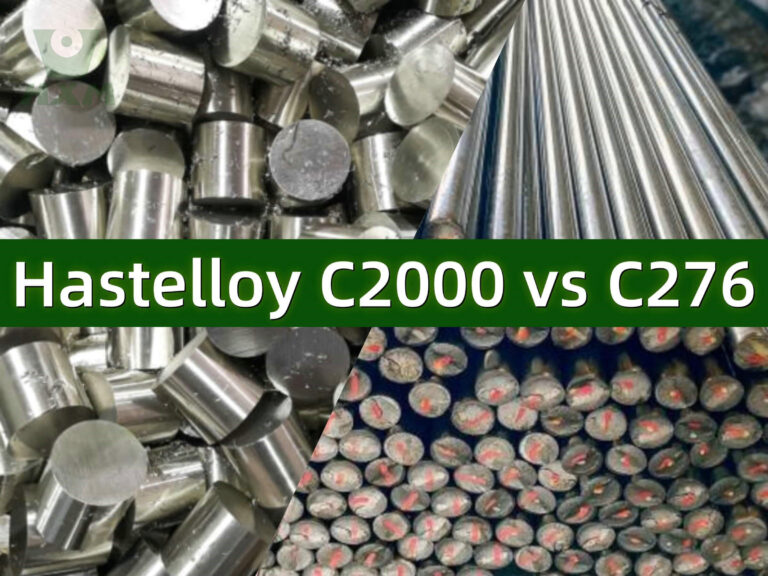
In the realm of corrosion-resistant alloys, Hastelloy C2000 vs C276 occupy a prominent place, each with unique characteristics that make them suitable for specific industrial applications. Both alloys are nickel-based superalloys that exhibit excellent resistance to a wide range of corrosive environments. However, there are several key differences between Hastelloy C2000 and C276 in terms of composition, mechanical properties, corrosion resistance, and applications.
What is Hastelloy C2000?
Hastelloy C2000 is a versatile corrosion-resistant alloy primarily composed of nickel, with significant amounts of molybdenum, chromium, and copper. It is specifically designed to provide exceptional resistance to a wide range of aggressive environments, including both oxidizing and reducing conditions.
Here’s a detailed overview:
1. Chemical Composition
| Element | Content (%) |
|---|---|
| Nickel (Ni) | Balance |
| Chromium (Cr) | 22.0 – 24.5 |
| Molybdenum (Mo) | 15.0 – 17.0 |
| Copper (Cu) | 1.3 – 1.9 |
| Iron (Fe) | 3.0 – 6.0 |
| Cobalt (Co) | ≤ 2.5 |
| Tungsten (W) | ≤ 3.0 |
| Carbon (C) | ≤ 0.01 |
| Manganese (Mn) | ≤ 0.5 |
| Silicon (Si) | ≤ 0.08 |
| Phosphorus (P) | ≤ 0.02 |
| Sulfur (S) | ≤ 0.02 |
The addition of copper enhances the alloy’s resistance to acid attacks, particularly against sulfuric acid.
2. Key Properties
-
Corrosion Resistance:
- Outstanding resistance to oxidizing and reducing agents.
- Particularly effective against chloride-induced pitting, stress corrosion cracking, and crevice corrosion.
- Excellent resistance to strong acids like sulfuric acid, hydrochloric acid, and phosphoric acid.
-
Thermal Stability:
- Good mechanical and corrosion-resistant properties at both high and low temperatures.
-
Fabrication:
- Easily fabricated using standard methods like welding, machining, and forming.
- Exhibits good weldability and does not require post-weld heat treatment.
-
Mechanical Properties:
- High tensile strength and excellent durability.
3. Applications
Hastelloy C2000 is used in industries where extreme chemical environments and high temperatures are present:
Chemical Processing:
- Reactors, heat exchangers, and piping systems exposed to aggressive acids and oxidizers.
Pharmaceutical Industry:
- Equipment for manufacturing and processing chemicals used in pharmaceuticals.
Pollution Control:
- Flue gas scrubbers, fans, and ducts used in sulfur dioxide removal.
Aerospace Industry:
- Components subjected to extreme corrosive environments.
Marine Applications:
- Equipment used in seawater environments where corrosion resistance is crucial.
4. Comparison to Other Hastelloy Grades
Hastelloy C2000 is unique among Hastelloy grades because of its enhanced corrosion resistance due to the addition of copper. While similar to Hastelloy C276, it provides better performance in environments with mixed oxidizing and reducing conditions.
5. Benefits of Hastelloy C2000
- Enhanced Versatility: Handles both oxidizing and reducing conditions, minimizing the need for multiple materials in complex systems.
- Durability: High strength and resistance to mechanical wear.
- Longevity: Withstands harsh conditions, reducing downtime and replacement costs.
- Fabrication: Easy to machine and weld, reducing manufacturing complexity.

Hastelloy C-276 belongs to nickel-molybdenum-chromium-iron-tungsten nickel-based alloy, which is one of the most corrosion-resistant modern metal materials.

Hastelloy X is a nickel-based superalloy known for its exceptional high-temperature strength and oxidation resistance.
What is Hastelloy C276?
Hastelloy C276 is a highly corrosion-resistant nickel-molybdenum-chromium alloy, designed to perform in extremely harsh environments. Known for its outstanding resistance to strong oxidizing and reducing agents, it is widely used in industries that demand superior corrosion resistance.
1. Chemical Composition
| Element | Content (%) |
|---|---|
| Nickel (Ni) | Balance |
| Molybdenum (Mo) | 15.0 – 17.0 |
| Chromium (Cr) | 14.5 – 16.5 |
| Iron (Fe) | 4.0 – 7.0 |
| Tungsten (W) | 3.0 – 4.5 |
| Cobalt (Co) | ≤ 2.5 |
| Manganese (Mn) | ≤ 1.0 |
| Silicon (Si) | ≤ 0.08 |
| Carbon (C) | ≤ 0.01 |
| Phosphorus (P) | ≤ 0.04 |
| Sulfur (S) | ≤ 0.03 |
This combination makes Hastelloy C276 particularly effective against chloride stress corrosion cracking, pitting, and crevice corrosion.
2. Key Properties
-
Corrosion Resistance:
- Exceptional resistance to strong oxidizers like ferric acids and cupric acids.
- Outstanding performance in reducing agents such as hydrochloric acid, sulfuric acid, and phosphoric acid.
- High resistance to chloride-induced pitting and crevice corrosion.
-
Thermal Stability:
- Performs effectively in high-temperature environments (up to 425°C or 800°F) without losing corrosion resistance.
-
Fabricability:
- Can be easily welded and fabricated using standard techniques without losing performance characteristics.
- Does not require post-weld heat treatment to maintain resistance to intergranular corrosion.
-
Mechanical Strength:
- Excellent strength and ductility, even at elevated temperatures.
3. Applications
Hastelloy C276 is used in a wide variety of industries where chemical and temperature resistance is critical:
Chemical Processing:
- Reactors, heat exchangers, and piping systems exposed to aggressive chemicals.
- Suitable for environments with mixed oxidizing and reducing conditions.
Pharmaceutical and Food Industries:
- Equipment exposed to harsh cleaning agents and corrosive solutions.
Pollution Control:
- Scrubbers, ducts, and fans in flue gas desulfurization systems, especially in environments with sulfur dioxide and chloride compounds.
Marine Industry:
- Used in seawater environments where corrosion resistance is essential.
Energy Industry:
- Components in nuclear reactors, geothermal plants, and offshore oil and gas applications.
4. Benefits of Hastelloy C276
- Broad Resistance: Performs in a wide range of chemical environments, reducing the need for material substitution.
- Longevity: Resistant to both pitting and stress corrosion cracking, leading to longer service life.
- Versatility: Suitable for both oxidizing and reducing conditions.
- Ease of Fabrication: High weldability and machinability make it convenient to use in complex systems.
5. Comparison to Other Hastelloy Grades
- Versus Hastelloy C2000:
- C276 is highly specialized for environments requiring resistance to mixed acids and chlorides.
- C2000 adds copper, improving performance in sulfuric acid environments but reducing versatility slightly.
- Versus Hastelloy C22:
- C22 offers better resistance to oxidizing environments, but C276 is more balanced for mixed chemical exposures.
6. Limitations
- Cost: Hastelloy C276 is relatively expensive due to its high-performance alloying elements.
- Availability: As a specialized material, it may have longer lead times compared to general-purpose alloys.

Hastelloy C-276 belongs to nickel-molybdenum-chromium-iron-tungsten nickel-based alloy, which is one of the most corrosion-resistant modern metal materials.

Hastelloy X is a nickel-based superalloy known for its exceptional high-temperature strength and oxidation resistance.
Hastelloy C2000 vs C276: What's the Difference?
Hastelloy C2000 vs C276: Composition
The composition of Hastelloy C2000 and C276 is what sets them apart. Hastelloy C2000 is an alloy with a high molybdenum content, which gives it its resistance to pitting and crevice corrosion in chloride-containing environments. It also contains chromium, iron, and tungsten, which contribute to its overall corrosion resistance.
On the other hand, Hastelloy C276 has a higher chromium content than C2000, along with molybdenum, nickel, and iron. The addition of tungsten and cobalt further enhances its corrosion resistance, particularly in aggressive media such as sulfuric acid.
Hastelloy C2000 vs C276: Mechanical Properties
Mechanically, Hastelloy C2000 and C276 exhibit different characteristics. Hastelloy C2000 offers good strength and ductility, making it suitable for applications that require both corrosion resistance and mechanical integrity. It also has good weldability and can be easily fabricated into complex shapes.
Hastelloy C276, on the other hand, is stronger and more ductile than C2000, making it a better choice for applications that require high strength and corrosion resistance. It also has superior fatigue resistance, making it suitable for dynamic loading conditions.
Hastelloy C2000 vs C276: Corrosion Resistance
Both Hastelloy C2000 and C276 exhibit excellent corrosion resistance, but their resistance profiles differ slightly. Hastelloy C2000 is particularly resistant to chloride-induced stress-corrosion cracking and pitting corrosion in seawater and other chloride-containing environments. It is also resistant to corrosion by reducing acids, such as sulfuric acid.
Hastelloy C276, on the other hand, offers even better resistance to a wide range of corrosive media, including oxidizing acids, reducing acids, and chloride-containing environments. Its high chromium content makes it resistant to corrosion by oxidizing agents, while its molybdenum and tungsten content enhance its resistance to reducing acids.
Hastelloy C2000 vs C276: Applications
The unique properties of Hastelloy C2000 and C276 make them suitable for different industrial applications. Hastelloy C2000 is commonly used in chemical processing equipment, pollution control systems, and off-shore oil and gas production equipment due to its resistance to chloride-induced corrosion.
Hastelloy C276, with its superior corrosion resistance, is widely used in more aggressive environments such as acid processing equipment, waste treatment systems, and high-temperature chemical processing applications. It is also used in the aerospace and nuclear industries due to its resistance to radiation-induced degradation.
Why Choose Huaxiao Alloy?
In summary, Hastelloy C2000 and C276 are both excellent alloys for corrosion-resistant applications, but they differ in composition, mechanical properties, and corrosion resistance. C2000 is suitable for chloride-containing environments and offers good strength and ductility, while C276 offers superior resistance to a wide range of corrosive media and has higher strength and ductility.
Thank you for reading our article and we hope it can help you to have a better understanding of the differences between Hastelloy C2000 vs C276. If you are looking for Hastelloy C2000 & C276 suppliers online now, please don’t hesitate to contact Huaxiao Alloy.
As a leading supplier of Hastelloy Alloys from Shanghai China, Huaxiao Alloy provides customers with Hastelloy C2000, Hastelloy B3 (UNS N10675), Hastelloy D205, Hastelloy G30 (UNS N06030), Hastelloy B2, Hastelloy X alloy, Hastelloy C4, Hastelloy C-276, and Hastelloy C22 at a very competitive price.

Hastelloy C-276 belongs to nickel-molybdenum-chromium-iron-tungsten nickel-based alloy, which is one of the most corrosion-resistant modern metal materials.

Hastelloy X is a nickel-based superalloy known for its exceptional high-temperature strength and oxidation resistance.
C2000 is a highly versatile nickel-chromium-molybdenum alloy with the addition of copper, designed to offer exceptional corrosion resistance in both oxidizing and reducing environments. It is part of the Hastelloy family and is particularly effective in handling aggressive acids like sulfuric acid, hydrochloric acid, and mixed environments.
Key Features:
- Superior resistance to pitting, crevice corrosion, and stress corrosion cracking.
- The addition of copper improves resistance to sulfuric acid.
- Ideal for chemical processing, marine applications, and pollution control systems.
Equivalent materials to Hastelloy C276 are high-performance alloys with similar chemical composition and corrosion resistance. They include:
International Standards:
- UNS N10276: Unified Numbering System.
- DIN 2.4819: German Standard.
- ISO NW 0276: International Standard.
Commercial Equivalents:
- Inconel C276: Another trade name for the same alloy.
- ATI 276: Produced by ATI.
- VdM Alloy C276: Manufactured by VDM Metals.
These equivalents have nearly identical properties, making them interchangeable in most applications.
| Property | Hastelloy C4 | Hastelloy C276 |
|---|---|---|
| Chemical Composition | Higher nickel content, no tungsten. | Contains tungsten (3-4.5%) for improved corrosion resistance. |
| Corrosion Resistance | Excellent in oxidizing conditions. | Better in reducing and mixed environments, especially against chlorides. |
| Applications | Suitable for nitric acid applications. | More versatile, used in chemical processing and marine environments. |
| Thermal Stability | Excellent thermal stability. | Performs better in mixed chemical exposures. |
Key Difference: C276 is more versatile due to its added tungsten and broader resistance range, while C4 excels in oxidizing conditions.
| Property | Alloy 20 | Hastelloy C276 |
|---|---|---|
| Base Composition | Nickel-iron-chromium alloy. | Nickel-chromium-molybdenum alloy. |
| Corrosion Resistance | Excellent for sulfuric acid but limited in chlorides. | Superior in both oxidizing and reducing environments, including chlorides. |
| Cost | Lower cost. | Higher cost due to premium alloying elements. |
| Applications | Ideal for sulfuric acid environments (e.g., fertilizer production). | Used in chemical processing, marine, and pollution control applications. |
Key Difference: Alloy 20 is more cost-effective for sulfuric acid environments, while C276 provides better all-around corrosion resistance.
| Property | Hastelloy C2000 | Hastelloy C276 |
|---|---|---|
| Chemical Additions | Contains copper for sulfuric acid resistance. | Contains tungsten for improved overall corrosion resistance. |
| Corrosion Resistance | Better in sulfuric acid and mixed acid conditions. | Better in reducing environments and against chlorides. |
| Applications | Used in chemical processing involving mixed acids. | Preferred in marine, pollution control, and general chemical industries. |
Key Difference: C2000 is optimized for sulfuric acid environments, while C276 excels in broader corrosive conditions.
-
Exceptional Corrosion Resistance:
- Handles both oxidizing and reducing environments.
- Resistant to chloride pitting, crevice corrosion, and stress corrosion cracking.
-
High Thermal Stability:
- Performs well in high-temperature environments.
-
Versatility:
- Suitable for chemical processing, marine, and pollution control applications.
-
Ease of Fabrication:
- Weldable and does not require post-weld heat treatment.
-
Durability:
- Long service life, reducing maintenance and replacement costs.
| Feature | Hastelloy C22 | Hastelloy C276 |
|---|---|---|
| Corrosion Resistance | Better in oxidizing environments. | Better in reducing conditions and against chlorides. |
| Weldability | Excellent. | Excellent. |
| Applications | Chemical processing and environmental equipment. | Broadly used in marine and chemical industries. |
Conclusion: Choose C22 for oxidizing environments and C276 for reducing and mixed conditions.
The ASTM standards for Hastelloy C276 include:
- ASTM B575: Specification for plate, sheet, and strip.
- ASTM B619: Specification for welded pipe.
- ASTM B622: Specification for seamless pipe and tube.
- ASTM B626: Specification for welded tube.
These standards define the alloy’s chemical composition, mechanical properties, and manufacturing tolerances.









